Abstract
Three Trichomonas vaginalis isolates with low in vivo susceptibilities to metronidazole (95% curative dose, greater than 3 X 100 mg kg-1 in subcutaneous infections in mice) were compared with strain ATCC 30001 and with four isolates exhibiting high in vivo susceptibilities (95% curative dose, less than 3 X 15 mg kg-1). Activity of pyruvate:ferredoxin oxidoreductase, anaerobic fermentation, and anaerobic intracellular accumulation of [14C]metronidazole label showed no significant isolate-dependent differences which could be correlated with drug susceptibility. The results suggest that processes providing electrons for metronidazole activation are not defective in the resistant strains. Aerobiosis, known to inhibit the antimicrobial action of metronidazole, inhibited accumulation of label more strongly in resistant isolates than in susceptible ones. No differences were detected, however, between resistant and susceptible isolates in respiration, aerobic fermentation, and the specific activity of NADH and NADPH oxidases, the main terminal oxidases of T. vaginalis. These findings suggest that the production of electrons is not diminished under aerobic conditions. The inhibitory effect of aerobic conditions on metronidazole activation, possibly due to competition for the electrons, is markedly enhanced in the resistant isolates compared to the susceptible ones. The mechanism of this effect, however, remains unknown.
Full text
PDF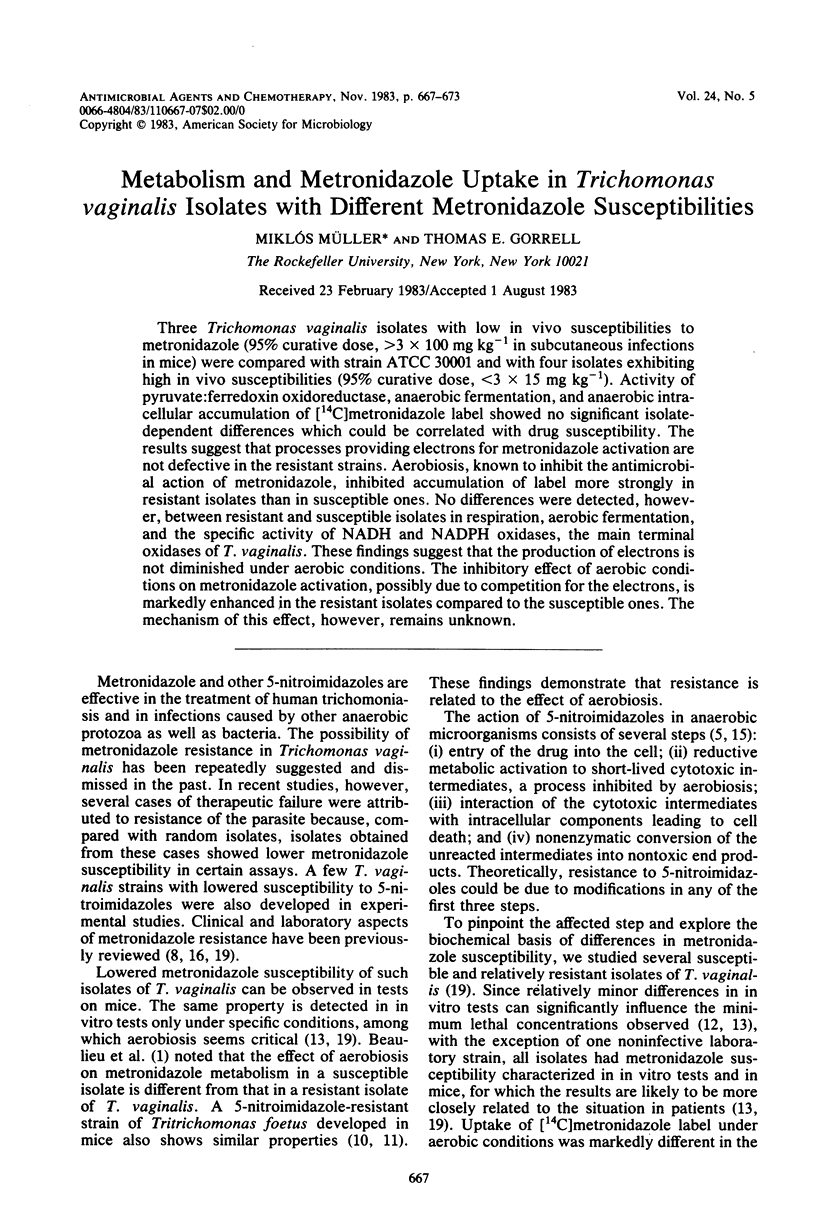
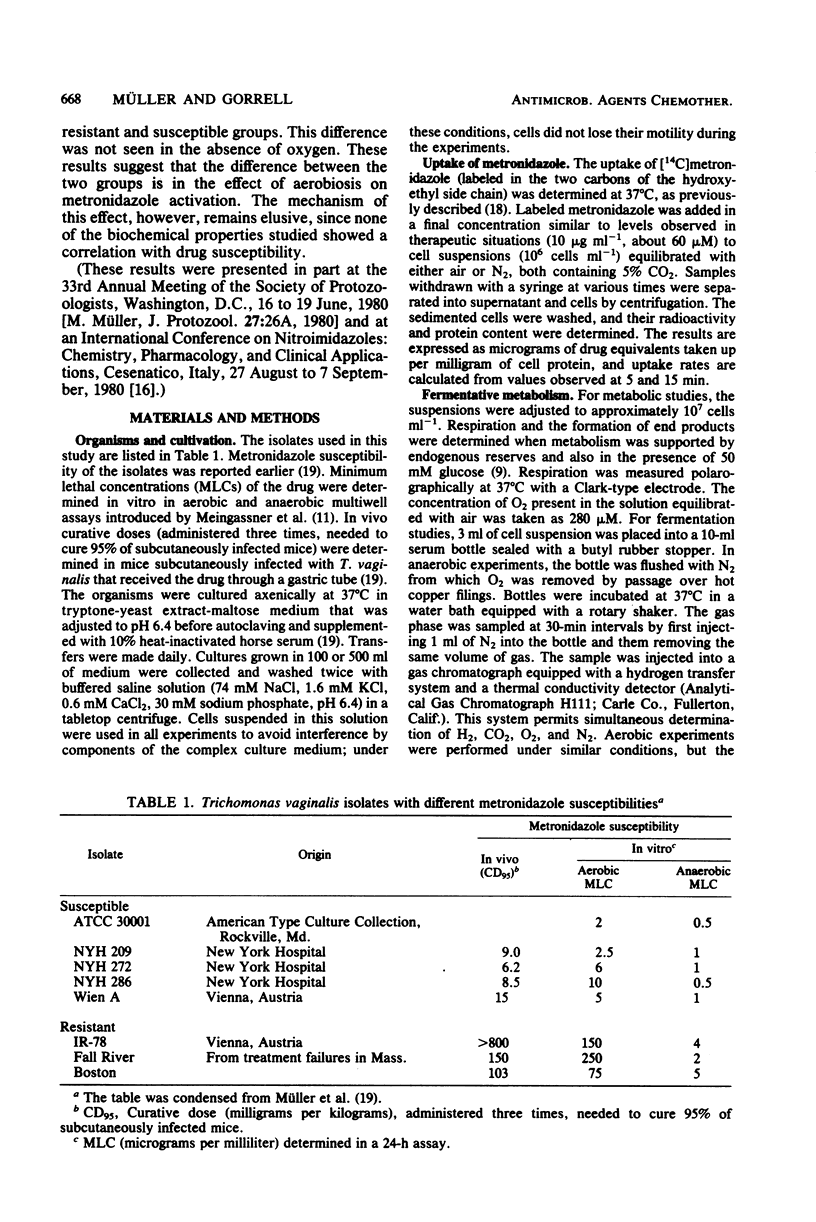
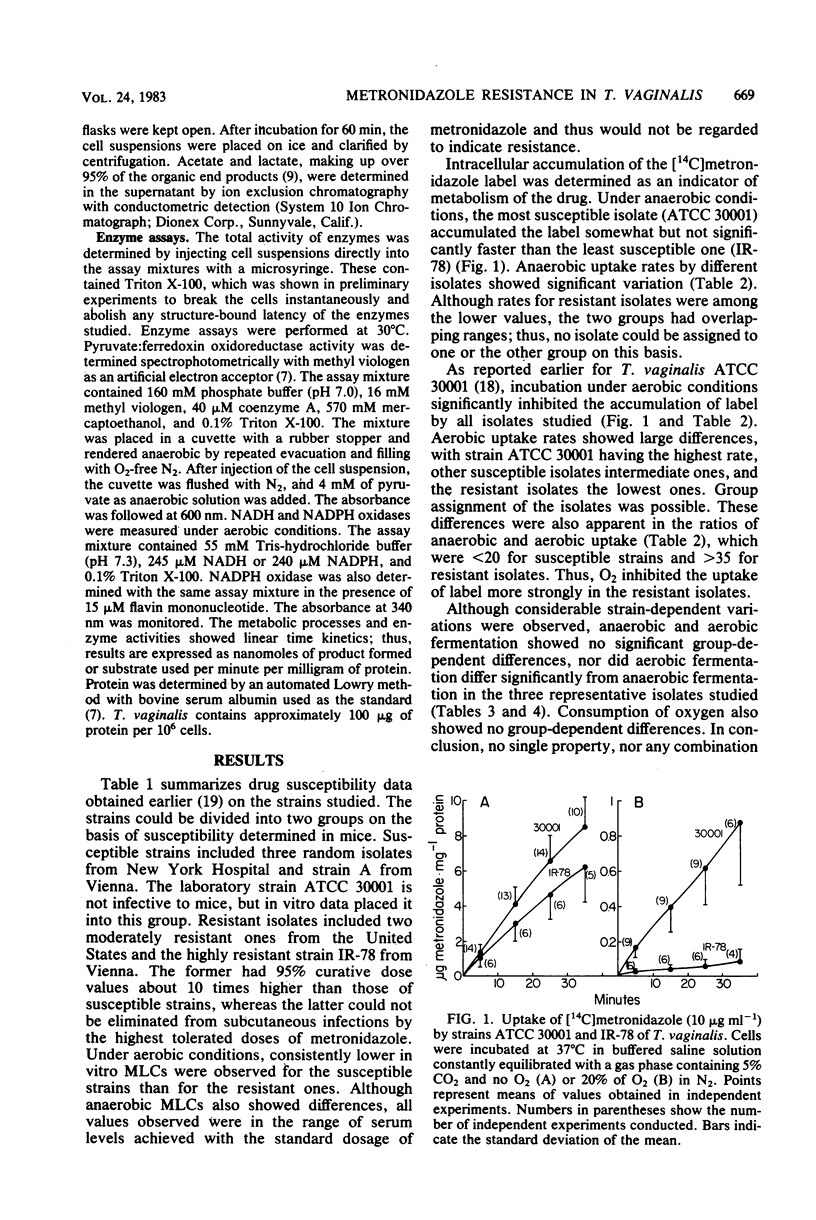
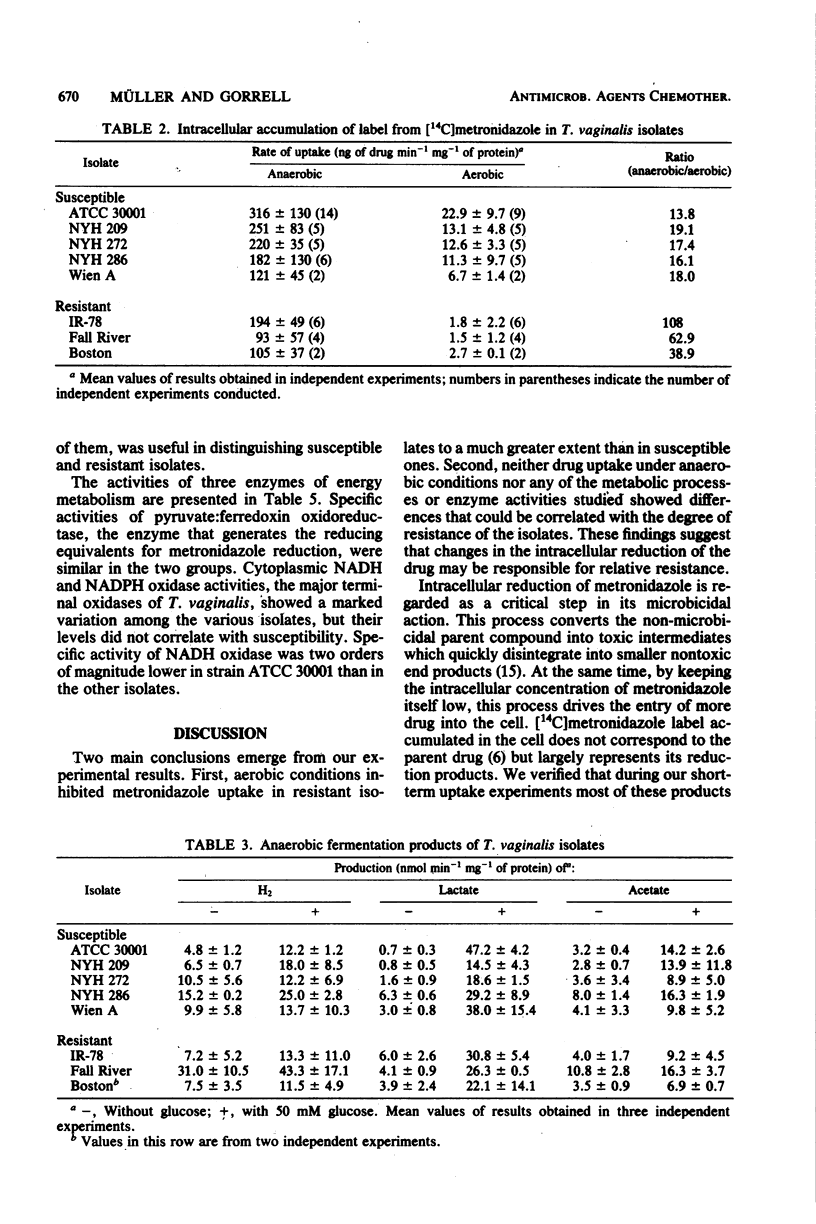
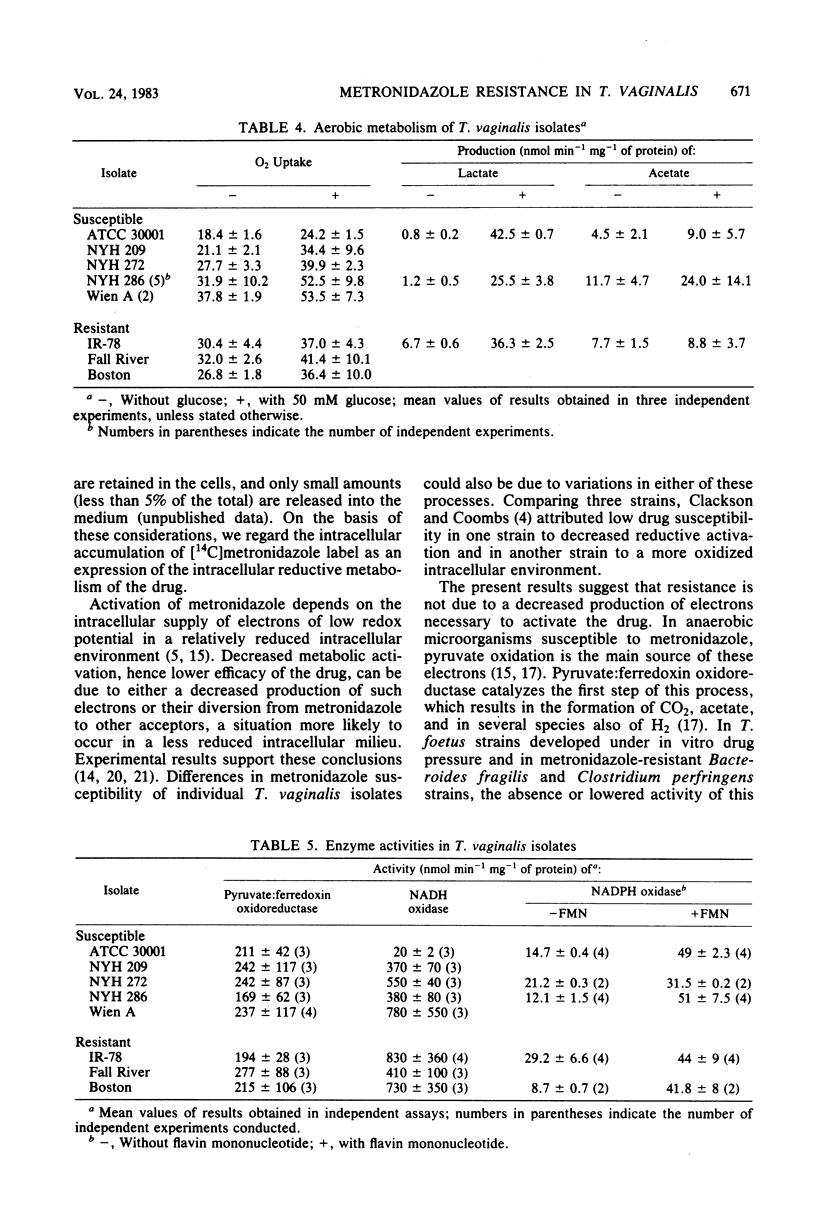


Selected References
These references are in PubMed. This may not be the complete list of references from this article.
- Beaulieu B. B., Jr, McLafferty M. A., Koch R. L., Goldman P. Metronidazole metabolism in cultures of Entamoeba histolytica and Trichomonas vaginalis. Antimicrob Agents Chemother. 1981 Sep;20(3):410–414. doi: 10.1128/aac.20.3.410. [DOI] [PMC free article] [PubMed] [Google Scholar]
- Edwards D. I. Mechanism of antimicrobial action of metronidazole. J Antimicrob Chemother. 1979 Sep;5(5):499–502. doi: 10.1093/jac/5.5.499. [DOI] [PubMed] [Google Scholar]
- Günther R., Müller W. Technik und Erfolgsbewertung der intraarteriellen Chemotherapie von Plattenepithelkarzinomen. Arch Geschwulstforsch. 1982;52(2):113–116. [PubMed] [Google Scholar]
- Ings R. M., McFadzean J. A., Ormerod W. E. The mode of action of metronidazole in Trichomonas vaginalis and other micro-organisms. Biochem Pharmacol. 1974 May 1;23(9):1421–1429. doi: 10.1016/0006-2952(74)90362-1. [DOI] [PubMed] [Google Scholar]
- Lindmark D. G., Müller M. Hydrogenosome, a cytoplasmic organelle of the anaerobic flagellate Tritrichomonas foetus, and its role in pyruvate metabolism. J Biol Chem. 1973 Nov 25;248(22):7724–7728. [PubMed] [Google Scholar]
- Meingassner J. G., Mieth H. Cross-resistance of Trichomonads to 5-nitroimidazole-derivatives. Experientia. 1976 Feb 15;32(2):183–184. doi: 10.1007/BF01937754. [DOI] [PubMed] [Google Scholar]
- Meingassner J. G., Mieth H., Czok R., Lindmark D. G., Müller M. Assay conditions and the demonstration of nitroimidazole resistance in Tritrichomonas foetus. Antimicrob Agents Chemother. 1978 Jan;13(1):1–3. doi: 10.1128/aac.13.1.1. [DOI] [PMC free article] [PubMed] [Google Scholar]
- Meingassner J. G., Stockinger K. Untersuchungen zur Identifikation metronidazolresistenter Trichomonas vaginalis-Stämme in vitro. Z Hautkr. 1981 Jan 1;56(1):7–15. [PubMed] [Google Scholar]
- Meingassner J. G., Thurner J. Strain of Trichomonas vaginalis resistant to metronidazole and other 5-nitroimidazoles. Antimicrob Agents Chemother. 1979 Feb;15(2):254–257. doi: 10.1128/aac.15.2.254. [DOI] [PMC free article] [PubMed] [Google Scholar]
- Milne S. E., Stokes E. J., Waterworth P. M. Incomplete anaerobiosis as a cause of metronidazole 'resistance'. J Clin Pathol. 1978 Oct;31(10):933–935. doi: 10.1136/jcp.31.10.933. [DOI] [PMC free article] [PubMed] [Google Scholar]
- Müller M. Action of clinically utilized 5-nitroimidazoles on microorganisms. Scand J Infect Dis Suppl. 1981;26:31–41. [PubMed] [Google Scholar]
- Müller M., Lindmark D. G. Uptake of metronidazole and its effect on viability in trichomonads and Entamoeba invadens under anaerobic and aerobic conditions. Antimicrob Agents Chemother. 1976 Apr;9(4):696–700. doi: 10.1128/aac.9.4.696. [DOI] [PMC free article] [PubMed] [Google Scholar]
- Müller M., Meingassner J. G., Miller W. A., Ledger W. J. Three metronidazole-resistant strains of Trichomonas vaginalis from the United States. Am J Obstet Gynecol. 1980 Dec 1;138(7 Pt 1):808–812. doi: 10.1016/s0002-9378(16)32741-7. [DOI] [PubMed] [Google Scholar]
- Müller M., Nseka V., Mack S. R., Lindmark D. G. Effects of 2,4-dinitrophenol on trichomonads and Entamoeba invadens. Comp Biochem Physiol B. 1979;64(1):97–100. doi: 10.1016/0305-0491(79)90189-5. [DOI] [PubMed] [Google Scholar]
- Nseka K., Müller M. L'action des inhibiteurs de la glycolyse sur l'absorption du métronidazole par les protozoaires Tritrichomonas foetus et Entamoeba invadens. C R Seances Soc Biol Fil. 1978;172(6):1094–1098. [PubMed] [Google Scholar]
- Sindar P., Britz M. L., Wilkinson R. G. Isolation and properties of metronidazole-resistant mutants of Clostridium perfringens. J Med Microbiol. 1982 Nov;15(4):503–509. doi: 10.1099/00222615-15-4-503. [DOI] [PubMed] [Google Scholar]


